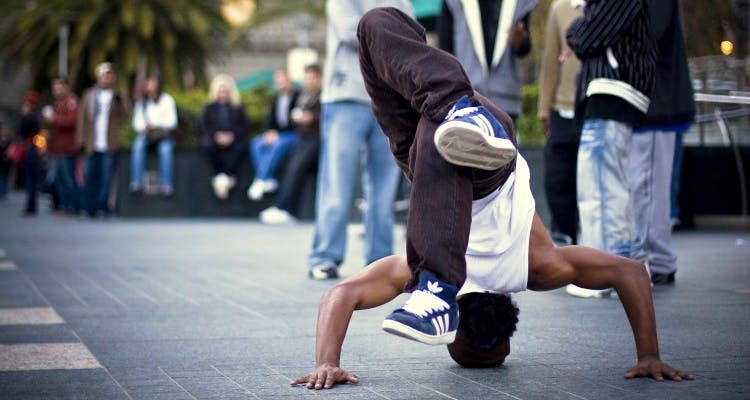By Rashi Wadhera
A far cry from perfect ballet buns and skintight leotard, hip-hop in all its forms seems to be ruling the Delhi dance scene. Our latest SYTYCD rendition, India’s Dancing Superstar, saw hip-hop crew MJ5 innovatively use all their B-boying roots to dance their way to stardom. The culture originally originated in New York among the Hispanic and African American community, and has always been synonymous with rap, turn tablism, graffiti art and street style. Hip-hop has evolved greatly over the years, and the dancing style has followed suit. Although New York already had its movement, fast forward forty years and India’s on the precipice of its own version. Every studio, every dance school and every other dance reality show showcases a plethora of hip-hop dancers. In keeping with the current dance climate, we're deconstructing all the types of hip-hop dance styles; so if you’re looking to do a class or just want an education, look no further.
The good news: Hip-hop dance is accessible to everyone. Unlike other more structured dance forms, hip-hop involves a lot of freestyle {relatively less time dedicated to technique}, and encourages individual interpretation of movement. But the truth is, it probably holds more cultural context than any other form. Historically, the movement was seen as evocative of the general mood surrounding violence and poverty; that’s where the hip-hop battles come from. Here’s the lowdown:
Disclaimer: A lot of studios uses different nomenclature across styles; this is to give you a broad overview.
Old School | Old school emerged in the 70’s and was almost a direct result of improv street moves. Old-school music to match is characterized by fast beats, which keep up with the moves, or the other way around {personal interpretation}. Think Bobby Brown, MC Hammer music videos as representative of this time. Under old school comes popping, locking and B-boying or break dancing, and although all of them may look like each other to an audience, here’s how you can tell them apart:
Popping: Very often {and understandably} confused with locking, this style is actually different. Popping involves a great deal of motion manipulation, twitching or jerking {called pops} to the beat, and heavy-duty isolations, which involve creating illusions that isolate a limb or body part.
Locking: Locking is characterized by sudden pauses or freezes {locks}, often in sync with the beat. It can be traced back to the late 60’s and was created by Don Campbell, back in a time where it was danced to traditional funk music {James Brown}. It relies on fast and distinct arm movements, with a more relaxed lower body. Lockers generally exaggerate their movements, bordering on comic, and choreography is based on a solid rhythmic understanding of a piece of music. Locking as a style can be interactive, and involves some funky terminology {Scoo B Doo, MuscleMan} and hectic movement.
B-boying or Breaking: Breaking, B-boying and breakdancing all refer to this style. It evolved as part of hip-hop culture among Latino and Black Americans in the South Bronx, NYC. Quite generic in its musicality, it’s danced to popular, commercial hip-hop music and even experiments with other genres. Four basic elements make up breaking - the Toprock, Downrock, Freeze and Power Moves. Don’t be breaking your focus; these terms only refer to different components of choreography, like the footwork, shuffling, posing, and acrobatic moves.
Street Dance | Street dance refers to a more fusion style. A routine can incorporate and borrow from different old school styles {now you know what this means}, to present a cohesive street hip-hop routine.
Lyrical | Lyrical is a more fluid and interpretive version of hip-hop, generally danced to slower, more downtempo hip-hop music and R&B tunes. The other thing about lyrical is that it focuses on emotion, and generally pays more attention to choreography, performance and story telling, as opposed to free styling and battles. The name comes from, yes, the lyrics of a song. Lyrical hip-hop uses a lot of literal translations and words of a song to inspire a piece.
Krumping | Although krumping isn’t very widespread as yet, it's picking up pace and therefore definitely deserves mention. Krumping encourages freedom and energy, perhaps a lot more than any of its dancing cousins. It has four basic movements - jabs, arm swings, stomps and chest pumps - and leaves transitions and other movement open to improv. Often bordering on violent and in your face, it's considered one of the most expressive styles.
Waacking and Voguing | Waacking is an African American street dance, with roots in the 70’s disco era. Sans the Afro, it consists of heavy-duty arm movement in sync with the music. Vogueing on the other hand, is a form of modern dance inspired by poses of models in various positions. For an easier reference, think of Vogue by Madonna. A lot of the vogueing movement is inspired by the way she used her hands and body to create angular and precise ‘poses’ or positions.
Studios to Hip-Hop at |
Brooklyn Academy of Dance and Arts | BADA teaches popping, locking, lyrical and freestyle/funk classes.
Where: D71 Basement, Malviya Nagar {Main Market Road}
To find out a full class schedule and rate list, visit them here.
Big Dance Centre | They offer a variety of hip-hop classes at all levels, including Urban, popping and good ol’ regular hip-hop. Also, MJ5 is on their faculty, so you’re in some great hands.
Where: 505, Ring Road Mall, Sector-3, Rohini
To find out a full class schedule and rate list, click here.
Delhi Dance Academy | DDA has breaking/B-boying classes on their schedule, along with regular hip-hop classes.
Where: E-238/239 Basement & E-1, Amar Colony, Lajpat Nagar
To find out a full class schedule and rate list visit them here or here.

